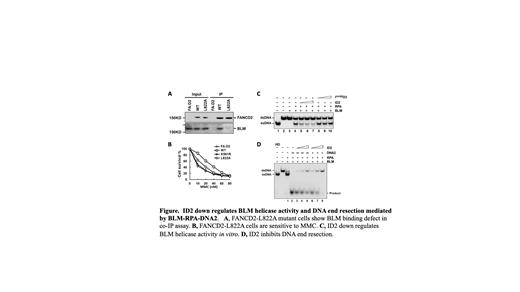Abstract
Background: Fanconi anemia (FA) is a genetic disease characterized by bone marrow failure, developmental defects, and higher risk of cancer. Mutations in FA genes have been detected commonly in a large swath of cancers. In the FA DNA repair pathway, DNA damage induces the mono-ubiquitination of the FANCI-FANCD2 (ID2) heterodimer and this regulation licenses the execution of downstream DNA damage signaling and repair steps. In response to replication stress, FANCD2 also prevents replication fork collapse during S phase. Bloom syndrome (BS) is also a genomic instability disease, characterized by growth abnormalities and cancer predisposition. The single BS protein, BLM helicase, participates in DNA repair by promoting DNA end resection and double Holliday junction dissolution. It has been shown that BLM is involved in restart of stalled replication fork. FA and BS have functional interactions. In tumor DNA sequencing of the Yale Precision Tumor board, we identified a somatic 6 amino acid deletion in FANCD2 in a head and neck tumor, while a germline point mutation was found on the other allele. We have identified a FANCD2-L822A mutant with defective BLM binding, which was used to further investigate the role of FANCD2-BLM interaction in genome stability and DNA repair.
Methods: Highly purified proteins were used to investigate how ID2 affects helicase and DNA end resection activity of the BLM complex. HeLa, FANCD2-deficient, and FANCD2 corrected fibroblast cell lines were used to examine pRPA2 and RAD51 foci formation. We also used DNA fiber assay to detect end resection and isolation of proteins on nascent DNA (iPOND) assay to examine the RAD51 recruitment on replication fork.
Results: A somatic 6 amino acid deletion (p819-824) in FANCD2 was identified in a head and neck tumor. FA-D2 mutant cells expressing the mutant cDNA demonstrated defects in FANCD2 mono-ubiquitination and DNA damage hypersensitivity. A FANCD2-L822A mutant with defective BLM binding was identified (Figure A, B). We found that Bloom helicase and its DNA end resection activity within BLM-DNA2-RPA were negatively regulated by the heterodimer ID2 (Figure C, D). Both DNA and BLM binding of the ID2 are required for the inhibitory function. The premature DNA end resection and HU sensitivity in FANCD2 deficient and mutant cells are rescued by BLM knockdown. By iPOND assay, we discovered that FANCD2 antagonizes BLM to promote RAD51 recruitment on HU-stalled replication fork.
Conclusions: Our study suggests that the DNA end resection activity of BLM-DNA2 is tightly regulated by FANCD2 to ensure that the nuclease DNA2 normally resects the DNA intermediate needed for efficient DNA repair and RAD51 recruitment to protect replication forks. Our findings highlight that ID2-BLM interaction functions in DNA damage repair to maintain genome stability.
No relevant conflicts of interest to declare.


This feature is available to Subscribers Only
Sign In or Create an Account Close Modal